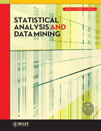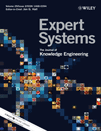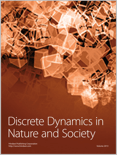
EPJ Data Science
Scope & Guideline
Fostering Collaboration in Computational Mathematics
Introduction
Aims and Scopes
- Interdisciplinary Data Science Research:
Highlights the integration of data science methodologies across various fields such as social sciences, economics, urban studies, and public health. - Quantitative Analysis and Empirical Methods:
Emphasizes rigorous quantitative methods, including statistical modeling, machine learning, and network analysis to derive insights from data. - Focus on Societal Challenges:
Addresses pressing societal issues through data analysis, including public health, social media dynamics, and economic behavior, contributing to informed policy-making. - Advancements in Computational Techniques:
Showcases innovative computational techniques and tools, such as large language models and network embeddings, enhancing data analysis capabilities. - Exploration of Human Behavior:
Investigates human mobility, social interactions, and behavioral patterns using data-driven insights to understand complex social phenomena.
Trending and Emerging
- Social Media Analysis and Misinformation:
A growing emphasis on analyzing social media dynamics, misinformation campaigns, and their societal impacts, particularly in the context of recent geopolitical events. - Human Mobility and Urban Dynamics:
Increased focus on understanding human mobility patterns and their implications for urban planning and public health, especially in light of the COVID-19 pandemic. - Artificial Intelligence and Ethics:
Emerging discussions around AI ethics, transparency, and accountability, as researchers explore the implications of AI technologies in various applications. - Network Science:
A trend towards utilizing network science to understand complex interactions across social, economic, and biological systems, highlighting the interconnectedness of data. - Sustainability and Environmental Impact:
Growing interest in assessing sustainability through data science, including the analysis of environmental factors and their influence on social behaviors.
Declining or Waning
- Traditional Statistical Methods:
There is a noticeable reduction in the application of traditional statistical methods in favor of more advanced computational techniques and machine learning approaches. - Isolated Case Studies:
The journal has shifted towards broader analyses and comprehensive data-driven investigations rather than isolated case studies, which are becoming less frequent. - Descriptive Analytics:
A decline in purely descriptive analytics is observed as the journal increasingly favors predictive modeling and causal inference methodologies. - Single-Domain Studies:
Research that focuses exclusively on single domains without interdisciplinary connections appears to be waning, with a stronger emphasis on interdisciplinary approaches.
Similar Journals

Annals of the University of Craiova-Mathematics and Computer Science Series
Shaping Tomorrow’s Technologies through Rigorous ResearchAnnals of the University of Craiova-Mathematics and Computer Science Series, published by UNIV CRAIOVA, is a distinguished academic journal that serves as a platform for advancing knowledge in the fields of mathematics and computer science. With an ISSN of 1223-6934 and an E-ISSN of 2246-9958, the journal has been disseminating high-quality research since its inception in 2011 and is targeted toward researchers, professionals, and students from these dynamic fields. It has been recognized in the Q3 category for both Computer Science Applications and Mathematics (miscellaneous) as of 2023, highlighting its emerging influence in the academic community, despite its current Scopus Rankings placing it at 42nd percentile for Mathematics and 14th percentile for Computer Science Applications. The journal's commitment to open access and its ongoing contributions until 2024 position it as a vital resource for fostering collaboration and innovation in Romania and beyond. Researchers interested in mathematics and computer science will find valuable insights and cutting-edge studies within its pages.

Statistical Analysis and Data Mining
Transforming Data into Actionable InsightsStatistical Analysis and Data Mining is a leading journal published by WILEY, dedicated to exploring the latest advancements in statistical methods and data mining techniques. With an ISSN of 1932-1864 and an E-ISSN of 1932-1872, this journal serves as a significant platform for researchers and professionals in statistical analysis, computer science applications, and information systems. Covering a wide range of topics from innovative analytical methodologies to emerging data mining algorithms, the journal aims to disseminate high-quality research that contributes to the evolving landscape of data science. Ranked in the Q2 category for the fields of Analysis, Computer Science Applications, and Information Systems in 2023, it emphasizes its relevance and impact within academia. While it offers limited Open Access options, the insights shared in this publication are integral for those wishing to stay ahead in fast-paced research and data-driven industries. Since its inception in 2008 and continuing through 2024, Statistical Analysis and Data Mining invites submissions that reflect rigorous empirical research coupled with practical implications, making it a vital resource for the academic community.

Proceedings of the Romanian Academy Series A-Mathematics Physics Technical Sciences Information Science
Exploring Innovations in Technical Sciences and InformationProceedings of the Romanian Academy Series A-Mathematics Physics Technical Sciences Information Science, published by EDITURA ACAD ROMANE, is a noteworthy academic journal that serves as a platform for disseminating original research in the intersecting fields of mathematics, physics, engineering, and computer science. With an ISSN of 1454-9069, this journal not only highlights the vibrant academic contributions from Romania but also attracts international submissions, thus fostering global collaboration. Though it currently does not offer an open-access model, the journal remains indexed in significant databases, reflecting its commitment to quality and scholarly rigor. The journal’s impact can be seen through its rankings, including Q4 in Computer Science, Q3 in Engineering, and Q4 across Mathematics and Physics, as well as its Scopus percentile rankings, which indicate meaningful contributions to these domains. With a converged publication span from 2008 to 2024, it aims to catalyze advancements in technical sciences while enriching the academic discourse among researchers, professionals, and students alike. The journal’s headquarters in Bucharest, Romania, positions it as a key player in the Eastern European academic landscape, making it essential reading for those engaged in cutting-edge research.

Data
Fostering collaboration in the world of data science.Data is an innovative open-access journal published by MDPI, dedicated to advancing research and knowledge in the fields of Computer Science and Information Systems. Since its inception in 2016, Data has positioned itself as a prominent platform for disseminating high-quality research, currently boasting an impact factor reflective of its rigorous peer-review process and academic standards. Situated in Switzerland, the journal encompasses a broad scope of topics, making it an essential resource for researchers, professionals, and students alike. With a notable standing in multiple categories—including Q2 rankings in Information Systems and Information Systems and Management—the journal facilitates access to cutting-edge findings and methodologies that drive innovation in data management and analysis. Scholars are encouraged to utilize this open-access platform to share their findings and contribute to the collective understanding in these rapidly evolving fields.

Applied Network Science
Empowering researchers with open access to groundbreaking insights.Applied Network Science is a premier open access journal published by SpringerNature that has been a vital resource in the fields of computational mathematics and computer networks since its inception in 2016. With an impressive Q1 ranking in Multidisciplinary fields and Q2 rankings in both Computational Mathematics and Computer Networks and Communications, it distinguishes itself as a significant contributor to interdisciplinary research efforts. The journal fosters innovative methodologies and applications within network science, making it a crucial platform for researchers, professionals, and students alike. With an E-ISSN of 2364-8228 and a commendable standing in global rankings, it supports a broad audience through its commitment to open access, ensuring that groundbreaking research is readily available. Located in Switzerland, Applied Network Science continues to shape the landscape of network research and communication, making substantial impacts across various domains.

Complex Systems
Transforming Complexity into Clarity and InnovationComplex Systems is a pivotal journal published by Complex Systems Publications Inc, specializing in the interdisciplinary field of complex systems science. With an ISSN of 0891-2513, it focuses on advancing the understanding of complex phenomena across various domains, including computer science and control engineering. Operating from the United States, this journal has established itself as a credible source with a current impact factor reflecting its relevance—ranking in the Q3 category for both Computer Science (miscellaneous) and Control and Systems Engineering as of 2023. Although it does not offer Open Access, Complex Systems aims to facilitate the exchange of cutting-edge research and innovative methodologies, making it indispensable for researchers, professionals, and students eager to explore and contribute to the field. With coverage spanning from 2012 to 2024, it strives to foster a deeper understanding of the principles governing complex systems, thus paving the way for future technological advancements and theoretical developments.

EXPERT SYSTEMS
Pioneering Research in Artificial Intelligence and Beyond.EXPERT SYSTEMS is a prestigious journal published by WILEY, dedicated to advancing the fields of Artificial Intelligence, Computational Theory and Mathematics, Control and Systems Engineering, and Theoretical Computer Science. Established in 1984, this journal has consistently provided a platform for rigorous research, showcasing innovative methodologies and applications that drive the future of intelligent systems. With an impressive impact factor and Scopus rankings placing it among the top quartiles within its categories, EXPERT SYSTEMS is a vital resource for researchers, professionals, and students seeking to deepen their understanding of complex systems and their applications. The journal is not currently an Open Access publication, emphasizing its commitment to high-quality, peer-reviewed research that impacts the global academic community. With a convergence year extending to 2024, it prepares to continue its legacy as a cornerstone of knowledge in these dynamic fields.

DISCRETE DYNAMICS IN NATURE AND SOCIETY
Fostering Innovation in Discrete Modeling for a Global AudienceDISCRETE DYNAMICS IN NATURE AND SOCIETY is a leading academic journal published by HINDAWI LTD, specializing in the intricate interrelationship between discrete modeling and its applications in both natural phenomena and societal dynamics. Established as an Open Access journal since 1997, it ensures that research outputs are freely accessible to a global audience, fostering collaboration and innovation within the field. Based in the United States, this journal has seen substantial contributions to the domains of mathematics, modeling, and simulation, achieving a commendable Q3 category ranking for its impact in these areas. With its robust focus on empirical research and the theoretical underpinnings of discrete systems, the journal appeals to a diverse readership including researchers, professionals, and students eager to explore and contribute to the ongoing discussions shaping our understanding of dynamics in complex systems.

Computational and Mathematical Methods
Innovating Solutions Through Computational InsightsComputational and Mathematical Methods is a dynamic peer-reviewed journal published by Wiley-Hindawi, focusing on innovative research in the fields of computational mathematics, mechanics, and theory. Since its transition to an Open Access format in 2022, the journal has enhanced its accessibility to researchers and practitioners globally, providing a platform for the dissemination of high-quality studies that contribute to emerging developments in mathematical modeling and computational techniques. Based in the United Kingdom, this journal is committed to fostering collaboration amongst scholars, evidenced by its rankings within Scopus: Q3 in computational mathematics, computational mechanics, and computational theory and mathematics, reflecting its relevance and influence within these critical fields. With an emphasis on interdisciplinary studies, Computational and Mathematical Methods is an essential resource for researchers, professionals, and students seeking to expand their knowledge and apply cutting-edge methodologies to practical challenges.

Computational and Mathematical Organization Theory
Innovative methodologies for a new era of organizational theory.Computational and Mathematical Organization Theory, published by SPRINGER, is a prominent journal specializing in the intersection of mathematical and computational methodologies within organizational theory. With its ISSN 1381-298X and E-ISSN 1572-9346, this journal has established itself as a critical source of cutting-edge research since its inception in 1995 and continues to thrive with contributions spanning from 2005 to 2024. Noteworthy is its recognition in the 2023 quartile rankings, where it holds a Q2 status across multiple categories, such as Applied Mathematics, Computational Mathematics, and Decision Sciences, reflecting its broad analytical scope and the relevance of its findings to diverse fields. Furthermore, its Scopus rankings position it favorably within the academic community, underscoring its significant impact in Applied Mathematics (Rank #156/635), Computational Mathematics (Rank #59/189), and Modeling and Simulation (Rank #122/324). Although the journal is not open access, it provides crucial insights and methodologies that aid researchers and practitioners in enhancing organizational processes through mathematical and computational lenses. For scholars seeking to advance their understanding and application of these interdisciplinary approaches, Computational and Mathematical Organization Theory serves as an invaluable resource in the ever-evolving landscape of academic inquiry.